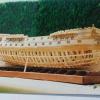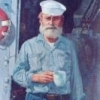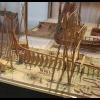-
Posts
154 -
Joined
-
Last visited
Reputation Activity
-
 jre8655 got a reaction from CaptainSteve in Bluenose by jre8655 - FINISHED - Model Shipways - Scale 1:100
jre8655 got a reaction from CaptainSteve in Bluenose by jre8655 - FINISHED - Model Shipways - Scale 1:100
Time to install the rudder.
The instructions called for the rudder to be butt glued to the keel then the copper strips glued to the outside of the rudder and keel to simulate the hinges.
This just didn’t look right to me so…I cut two pieces of 1/32nd inch piano wire, drilled the rudder, and inserted the wires into the holes. I formed the copper strips (hinges) around the rudder and around the keel. The hinges that would conceal the wires were notched so the wires would fit between the two hinges.
The rudder was lined up to the keel and holes drilled in the keel to accept the wires.
The hinges were glued to the keel and rudder then the rudder wires were inserted into the keel and glued with epoxy.
The overall affect is that the rudder is spaced from the keel by about 1mm. This gives a more realistic look to the assembly.
-
 jre8655 got a reaction from GrandpaPhil in Bluenose by jre8655 - FINISHED - Model Shipways - Scale 1:100
jre8655 got a reaction from GrandpaPhil in Bluenose by jre8655 - FINISHED - Model Shipways - Scale 1:100
I present, for your inspection and critique, my completed rendition of the Canadian Schooner Bluenose.
I tied the last knot at 1730 hour MST this evening.
Just to add a bit of authenticity and acquire official approval of the model, I asked my neighbor to come over. He, being from Canada, inspected the model and gave me a thumbs up.
From start to finish this has been an adventure. I am very pleased with the Model Shipways Kit and the quality woods and especially the building manual. Granted, there are a number of improvements that can be made to any kit, but overall this is a well thought out product.
I’ve learned to bend and shape various woods, sew sails, and above all patience!
My next step is to complete the display case and mount the Bluenose.
To all of you that have followed this build and provided instruction, and inspiration, I thank you.
-
 jre8655 got a reaction from ulrich in How to build a wood case ?
jre8655 got a reaction from ulrich in How to build a wood case ?
Using the dimensions you posted, your case should be about the same size as the one I made for my Bluenose.
I made that case using Poplar. The base is 24" x 7.5" x 3/4". All the pieces for the frame are of 3/4" square Poplar. The case is 23" high.
Here are some photos of the case construction:
All the acrylic is Lexan and the pieces slide into 1/8" grooves I cut using a MicroLux miniature table saw.
The wood frame certainly provides strength and you don't have to worry about trying glue the acrylic itself.
I believe that at some point you will have to use a table saw to cut the parts. If you know someone that has one, you could ask to use it for the amount of time it would take to cut and groove all the parts.
-
 jre8655 got a reaction from AON in How to build a wood case ?
jre8655 got a reaction from AON in How to build a wood case ?
Using the dimensions you posted, your case should be about the same size as the one I made for my Bluenose.
I made that case using Poplar. The base is 24" x 7.5" x 3/4". All the pieces for the frame are of 3/4" square Poplar. The case is 23" high.
Here are some photos of the case construction:
All the acrylic is Lexan and the pieces slide into 1/8" grooves I cut using a MicroLux miniature table saw.
The wood frame certainly provides strength and you don't have to worry about trying glue the acrylic itself.
I believe that at some point you will have to use a table saw to cut the parts. If you know someone that has one, you could ask to use it for the amount of time it would take to cut and groove all the parts.
-
 jre8655 got a reaction from AntonyUK in How to build a wood case ?
jre8655 got a reaction from AntonyUK in How to build a wood case ?
Using the dimensions you posted, your case should be about the same size as the one I made for my Bluenose.
I made that case using Poplar. The base is 24" x 7.5" x 3/4". All the pieces for the frame are of 3/4" square Poplar. The case is 23" high.
Here are some photos of the case construction:
All the acrylic is Lexan and the pieces slide into 1/8" grooves I cut using a MicroLux miniature table saw.
The wood frame certainly provides strength and you don't have to worry about trying glue the acrylic itself.
I believe that at some point you will have to use a table saw to cut the parts. If you know someone that has one, you could ask to use it for the amount of time it would take to cut and groove all the parts.
-
 jre8655 got a reaction from hexnut in Mayflower by Jack Tar - Model Shipways - scale: 5/32” = 1’
jre8655 got a reaction from hexnut in Mayflower by Jack Tar - Model Shipways - scale: 5/32” = 1’
Previously I made a comment that I was going to construct a jig to help prepare planks for this build. I wasn’t sure if the time spent designing and building such a jig would ultimately save future effort with the planks. Well here is the jig I came up with.
The center section of the jig is movable slides to clamp the planks between the two pieces of pine. These pieces were cut to a 3/32” thickness to accommodate 1/8” wide planks. This would allow for sanding the planks to the same thickness.
I spent one morning at our community woodshop and cut all the pieces from ¼” Masonite. The two lighter colored pieces are pine.
The idea was to have a clamp that would hold a number of planks so they could be gang sanded to the same width and length then edge colored to simulate the caulking.
To test the jig I cut 25, 1/32” x 1/8” planks and stacked them in my jig then closed it. There is enough friction between the pieces of Masonite to hold the plank stack, but if needed I can wrap a rubber band around the slides to add pressure.
Once in place it was a very quick operation to sand all the planks to the same dimensions.
After sanding, I colored the edges with a Prismacolor black pencil.
Now it’s on to applying the planks to the model.
-
 jre8655 got a reaction from hexnut in Mayflower by Jack Tar - Model Shipways - scale: 5/32” = 1’
jre8655 got a reaction from hexnut in Mayflower by Jack Tar - Model Shipways - scale: 5/32” = 1’
I used the first set of planks that I prepped with the plank jig for the stern and counter.
The instructions called for a layer of 1/16” x 1/8” planks to be applied to the counter. When I finished this set of planks I noted that there was a 1/16” drop from the stern piece ZZ to the counter. I found that I had to apply a second layer of 1/16” x 1/8” planks in order to achieve a smooth transition from stern piece ZZ into the counter. I’m thinking that maybe the planks should have been laid flat instead of upright; however, the plans show them laid upright.
Once these two layers of planks were sanded to shape and blended together I began the second layer of 1/32” x 1/8” planks. Per the instructions, the gun port lids are placed first.
With the gun port lids in place I transferred the angle of the planks from the plan sheet to an adjustable protractor (37°). The planks were then cut and applied to the stern piece ZZ and finally to the counter.
<
I realize that most of the stern planks will be covered with white paint so all this lovely caulking will be lost. I therefore considered this an opportunity for me to practice coloring the plank edges and laying the planks in preparation for the deck planking job that lies ahead.
-
 jre8655 got a reaction from mij in Mayflower by Jack Tar - Model Shipways - scale: 5/32” = 1’
jre8655 got a reaction from mij in Mayflower by Jack Tar - Model Shipways - scale: 5/32” = 1’
I used the first set of planks that I prepped with the plank jig for the stern and counter.
The instructions called for a layer of 1/16” x 1/8” planks to be applied to the counter. When I finished this set of planks I noted that there was a 1/16” drop from the stern piece ZZ to the counter. I found that I had to apply a second layer of 1/16” x 1/8” planks in order to achieve a smooth transition from stern piece ZZ into the counter. I’m thinking that maybe the planks should have been laid flat instead of upright; however, the plans show them laid upright.
Once these two layers of planks were sanded to shape and blended together I began the second layer of 1/32” x 1/8” planks. Per the instructions, the gun port lids are placed first.
With the gun port lids in place I transferred the angle of the planks from the plan sheet to an adjustable protractor (37°). The planks were then cut and applied to the stern piece ZZ and finally to the counter.
<
I realize that most of the stern planks will be covered with white paint so all this lovely caulking will be lost. I therefore considered this an opportunity for me to practice coloring the plank edges and laying the planks in preparation for the deck planking job that lies ahead.
-
 jre8655 got a reaction from WackoWolf in Airbrush results in "fuzz"
jre8655 got a reaction from WackoWolf in Airbrush results in "fuzz"
Typically when painting soft woods you really need to seal the grain with sanding sealer and/or a primer coat. This coat should be applied, sanded, reapplied, then a final sanding. The end result is a very smooth surface to apply your color over.
Using an airbrush, you should thin the paint to about a 50/50, paint to water, ratio. Apply a light first coat, let dry, sand with 800 grit, then apply a second coat. This second coat should dry overnight before being lightly sanded. Apply a third coat and you should have a very smooth color finish.
This approach has served me very well with several projects.
-
 jre8655 got a reaction from jml1083 in Bluenose by jre8655 - FINISHED - Model Shipways - Scale 1:100
jre8655 got a reaction from jml1083 in Bluenose by jre8655 - FINISHED - Model Shipways - Scale 1:100
I began the rigging process yesterday. I began by lashing the Main and Fore Sails to their respective booms and gaffs. The instructions and plans show the Main and Fore Sails lashed to the gaffs, but are secured to the booms only at the corners. Looking at the photos of the actual Bluenose it shows that these sails were lashed along the entire boom.
I decided to lash my sails to the booms and gaffs, but opted for a running stitch. Using a Tapestry Needle gave me enough of an eye in the needle to use 0.25mm rigging line. The running stitch also allowed me to adjust the tension on the lashing for a uniform appearance.
I used the same running stitch for the Fore Sail.
Because I already had the Mast Hoops in place I used a method described by Dave Borgens back in August. His method uses a simple cow hitch to secure the line on the Mast Hoop then running these lines through the sail to secure it to the Mast Hoop.
Couldn’t wait to see how the Main Sail looked on the model.
Now it’s just a matter of securing the appropriate rigging lines to the other sails.
-
 jre8655 got a reaction from Bindy in Bluenose by jre8655 - FINISHED - Model Shipways - Scale 1:100
jre8655 got a reaction from Bindy in Bluenose by jre8655 - FINISHED - Model Shipways - Scale 1:100
I used the time between building phases to get over to the community woodshop and whack out some lumber for a display case. As Yambo pointed out, I wanted to get her under cover before any dust, or fingerprints from the grandkids, settles on the rigging.
I used Poplar for my display case because it was readily available in the sizes I wanted and gives a nice contrast to the darkness of the Bluenose paint scheme.
The case is designed to be assembled around the model once it is secured to the base. The corner rails are secured to the base with brass wood screws and the top is then fitted to the corner rails and secured with brass wood screws.
I looked into purchasing glass for the display case, but found it to be very cost prohibitive. Regular single strength glass is too fragile and would break very easily and tempered glass is outrageously priced.
I discussed the use of various materials with a tech at Lowe’s and finally settled on using 1/8th inch Lexan instead of glass. At least I know it isn’t going to break and it will be indoors and out of the sun so I’m not too concerned about yellowing or clouding.
A while back I read a post describing some of the ways various builders put little treasures in their models. As the discussion progressed it was suggested that the build log for the model be somehow incorporated into the display. There were several suggestions including CD ROMs and then the use of a USB Flash Drive that could be encased with the model.
I purchased a number of 1 Gigabyte USB Flash Drives through Amazon and then set about designing a combination nameplate holder and USB box. This is my final result.
The USB Flash Drive, containing all my photos of the build and the complete build log, will be placed into the box and then the construction will be secured to the Display Case floor with brass screws.
Once the model is secured to the base of the display case and the nameplate/USB box is in place I’ll assemble the sides and secure the top.
This will finish my build log. My next post will be in the “Gallery of COMPLETED Kit-Built Ship Models” with the finished display case.
-
 jre8655 got a reaction from GrandpaPhil in Bluenose by jre8655 - FINISHED - Model Shipways - Scale 1:100
jre8655 got a reaction from GrandpaPhil in Bluenose by jre8655 - FINISHED - Model Shipways - Scale 1:100
I pretty much have to say that at this point my build of the Bluenose is finished. There is nothing else I can do except put it on the shelf and admire the finished product.
All the pieces of the display case were cut at our community woodshop. That kept all the sawdust out of my garage and house.
All the parts were tested to see if everything went together as planned. I had to make a small adjustment to the groves in the base, but other than that it went together nicely.
Here is the finished build. There really is nothing else to write down. I will post some photos in the Gallery of competed models.
Note the nameplate holder. The USB Flash Drive with my complete build log, resource material, and all photos is encased in the box built into the holder.
-
 jre8655 got a reaction from grizzler22 in If you were allowed only one power tool - what would it be?
jre8655 got a reaction from grizzler22 in If you were allowed only one power tool - what would it be?
Many years ago, around 1973, I purchased a Unimat SL. That thing was a variable (belt driven) combination lathe (metal and wood), drill press, verticle milling, table saw, jig saw, disc sander, flexible shaft handpiece, all around whatever you needed machine. There were so many accessories available that it was an entire workshop rolled up in one.
Wish I still had it!
-
 jre8655 got a reaction from Blue Pilot in Bluenose by jre8655 - FINISHED - Model Shipways - Scale 1:100
jre8655 got a reaction from Blue Pilot in Bluenose by jre8655 - FINISHED - Model Shipways - Scale 1:100
I pretty much have to say that at this point my build of the Bluenose is finished. There is nothing else I can do except put it on the shelf and admire the finished product.
All the pieces of the display case were cut at our community woodshop. That kept all the sawdust out of my garage and house.
All the parts were tested to see if everything went together as planned. I had to make a small adjustment to the groves in the base, but other than that it went together nicely.
Here is the finished build. There really is nothing else to write down. I will post some photos in the Gallery of competed models.
Note the nameplate holder. The USB Flash Drive with my complete build log, resource material, and all photos is encased in the box built into the holder.
-
 jre8655 got a reaction from Bindy in Bluenose by jre8655 - FINISHED - Model Shipways - Scale 1:100
jre8655 got a reaction from Bindy in Bluenose by jre8655 - FINISHED - Model Shipways - Scale 1:100
I pretty much have to say that at this point my build of the Bluenose is finished. There is nothing else I can do except put it on the shelf and admire the finished product.
All the pieces of the display case were cut at our community woodshop. That kept all the sawdust out of my garage and house.
All the parts were tested to see if everything went together as planned. I had to make a small adjustment to the groves in the base, but other than that it went together nicely.
Here is the finished build. There really is nothing else to write down. I will post some photos in the Gallery of competed models.
Note the nameplate holder. The USB Flash Drive with my complete build log, resource material, and all photos is encased in the box built into the holder.
-
 jre8655 got a reaction from hexnut in Bluenose by jre8655 - FINISHED - Model Shipways - Scale 1:100
jre8655 got a reaction from hexnut in Bluenose by jre8655 - FINISHED - Model Shipways - Scale 1:100
I pretty much have to say that at this point my build of the Bluenose is finished. There is nothing else I can do except put it on the shelf and admire the finished product.
All the pieces of the display case were cut at our community woodshop. That kept all the sawdust out of my garage and house.
All the parts were tested to see if everything went together as planned. I had to make a small adjustment to the groves in the base, but other than that it went together nicely.
Here is the finished build. There really is nothing else to write down. I will post some photos in the Gallery of competed models.
Note the nameplate holder. The USB Flash Drive with my complete build log, resource material, and all photos is encased in the box built into the holder.
-
 jre8655 got a reaction from 42rocker in Harbor Freight Workbench
jre8655 got a reaction from 42rocker in Harbor Freight Workbench
Mike,
I purchased the Harbor Frieght Workbench about three months ago. I love it!
It's as sturdy as any workbench I've either owned or used. Assembly was very easy and I was able to do it unassisted.
I waited until it went on sale for $129.95. I contemplated going to our local Harbor Frieght, but opted to have it shipped to my house because shipping was only $6.99. Yeah! $6.99 and it came from California.
-
 jre8655 got a reaction from Mac B in Mayflower by Jack Tar - Model Shipways - scale: 5/32” = 1’
jre8655 got a reaction from Mac B in Mayflower by Jack Tar - Model Shipways - scale: 5/32” = 1’
I used the first set of planks that I prepped with the plank jig for the stern and counter.
The instructions called for a layer of 1/16” x 1/8” planks to be applied to the counter. When I finished this set of planks I noted that there was a 1/16” drop from the stern piece ZZ to the counter. I found that I had to apply a second layer of 1/16” x 1/8” planks in order to achieve a smooth transition from stern piece ZZ into the counter. I’m thinking that maybe the planks should have been laid flat instead of upright; however, the plans show them laid upright.
Once these two layers of planks were sanded to shape and blended together I began the second layer of 1/32” x 1/8” planks. Per the instructions, the gun port lids are placed first.
With the gun port lids in place I transferred the angle of the planks from the plan sheet to an adjustable protractor (37°). The planks were then cut and applied to the stern piece ZZ and finally to the counter.
<
I realize that most of the stern planks will be covered with white paint so all this lovely caulking will be lost. I therefore considered this an opportunity for me to practice coloring the plank edges and laying the planks in preparation for the deck planking job that lies ahead.
-
 jre8655 got a reaction from mtaylor in How do you make your own rudder pintles and gudgeons?
jre8655 got a reaction from mtaylor in How do you make your own rudder pintles and gudgeons?
I ran into a similar problem on my 1:100 scale Bluenose. The instructions called for the rudder to be butt glued to the keel and then cutting the brass strips to lay on the outside of the hull and rudder. I didn't like the look of it so I did the following:
I cut two pieces of 1/32nd inch piano wire, drilled the rudder, and inserted the wires into the holes. I formed the copper strips (hinges) around the rudder and around the keel. The hinges that would conceal the wires were notched so the wires would fit between the two hinges.
The rudder was lined up to the keel and holes drilled in the keel to accept the wires.
The hinges were glued to the keel and rudder then the rudder wires were inserted into the keel and glued with epoxy.
The overall affect is that the rudder is spaced from the keel by about 1mm. This gives a more realistic look to the assembly.
-
 jre8655 got a reaction from riverboat in Mayflower by Jack Tar - Model Shipways - scale: 5/32” = 1’
jre8655 got a reaction from riverboat in Mayflower by Jack Tar - Model Shipways - scale: 5/32” = 1’
Previously I made a comment that I was going to construct a jig to help prepare planks for this build. I wasn’t sure if the time spent designing and building such a jig would ultimately save future effort with the planks. Well here is the jig I came up with.
The center section of the jig is movable slides to clamp the planks between the two pieces of pine. These pieces were cut to a 3/32” thickness to accommodate 1/8” wide planks. This would allow for sanding the planks to the same thickness.
I spent one morning at our community woodshop and cut all the pieces from ¼” Masonite. The two lighter colored pieces are pine.
The idea was to have a clamp that would hold a number of planks so they could be gang sanded to the same width and length then edge colored to simulate the caulking.
To test the jig I cut 25, 1/32” x 1/8” planks and stacked them in my jig then closed it. There is enough friction between the pieces of Masonite to hold the plank stack, but if needed I can wrap a rubber band around the slides to add pressure.
Once in place it was a very quick operation to sand all the planks to the same dimensions.
After sanding, I colored the edges with a Prismacolor black pencil.
Now it’s on to applying the planks to the model.
-
 jre8655 got a reaction from CaptainSteve in How do you make your own rudder pintles and gudgeons?
jre8655 got a reaction from CaptainSteve in How do you make your own rudder pintles and gudgeons?
I ran into a similar problem on my 1:100 scale Bluenose. The instructions called for the rudder to be butt glued to the keel and then cutting the brass strips to lay on the outside of the hull and rudder. I didn't like the look of it so I did the following:
I cut two pieces of 1/32nd inch piano wire, drilled the rudder, and inserted the wires into the holes. I formed the copper strips (hinges) around the rudder and around the keel. The hinges that would conceal the wires were notched so the wires would fit between the two hinges.
The rudder was lined up to the keel and holes drilled in the keel to accept the wires.
The hinges were glued to the keel and rudder then the rudder wires were inserted into the keel and glued with epoxy.
The overall affect is that the rudder is spaced from the keel by about 1mm. This gives a more realistic look to the assembly.
-
 jre8655 got a reaction from riverboat in Mayflower by Jack Tar - Model Shipways - scale: 5/32” = 1’
jre8655 got a reaction from riverboat in Mayflower by Jack Tar - Model Shipways - scale: 5/32” = 1’
All the decks are now glued in place and the upper sections of the bulkheads and decks are faired.
I’ve been reading over the instruction manual and delving into some of the other Mayflower build logs for information on planking the decks. Looking at the plans and the photos in the manual it looks as though the deck planks are laid down in very long sections.
I’m not sure what length these planks should be, but I’m thinking of making them about 1.5 to 2 inches in length. There is an illustration in the manual showing the deck planks much shorter than depicted in the photos. Any thoughts on this?
-
 jre8655 got a reaction from Mac B in Mayflower by Jack Tar - Model Shipways - scale: 5/32” = 1’
jre8655 got a reaction from Mac B in Mayflower by Jack Tar - Model Shipways - scale: 5/32” = 1’
Once I began fairing the bulkheads I realized that there were several places where it would be necessary to add some filler material to achieve a nice roundness to all the bulkheads. I decided to add filler blocks to most of the bulkheads to get the roundness I wanted and provide a wider gluing surface for the planking.
I used some scrap balsa for the fillers. I have a fair amount of experience with balsa from my days building model airplanes.
Now it’s time to get on with the planking.
-
 jre8655 got a reaction from Mac B in Mayflower by Jack Tar - Model Shipways - scale: 5/32” = 1’
jre8655 got a reaction from Mac B in Mayflower by Jack Tar - Model Shipways - scale: 5/32” = 1’
I cut loose all the bulkheads and test fitted them to the keel. With two minor exceptions the bulkheads all fit very nicely. Two of them required minimal filing to trim out the slots.
With everything lining up nicely and the keel is straight it’s time to start gluing. Thanks to those who posted build logs I followed their wisdom and invested in a container of Legos. Those babies sure come in handy!
One of the things I did before beginning any of the actual construction was to read through the instruction manual. I didn’t find anything about when, or where, to install the pedestals that come with the kit.
I realize that at some time in the future I will have to drill into the keel to mount the ship on these pedestals. I figured that I had better plan ahead and marked the locations for the pedestal screws. I marked these locations on both the keel and the plans.
At this stage of the build I made four reinforcement blocks and glued them to the keel in the locations I marked. I tried to drill a hold in a piece of the scrap the keel came out of and found it almost impossible to drill a straight hole without the bit drifting out one side or the other. That’s why I thought it a good idea to reinforce and drill these locations now.
Legos in hand, clamps at the ready, it was time to start gluing. This was actually fun! The way all the bulkheads fit the gluing went fairly fast.
-
 jre8655 got a reaction from themadchemist in How do you make your own rudder pintles and gudgeons?
jre8655 got a reaction from themadchemist in How do you make your own rudder pintles and gudgeons?
I ran into a similar problem on my 1:100 scale Bluenose. The instructions called for the rudder to be butt glued to the keel and then cutting the brass strips to lay on the outside of the hull and rudder. I didn't like the look of it so I did the following:
I cut two pieces of 1/32nd inch piano wire, drilled the rudder, and inserted the wires into the holes. I formed the copper strips (hinges) around the rudder and around the keel. The hinges that would conceal the wires were notched so the wires would fit between the two hinges.
The rudder was lined up to the keel and holes drilled in the keel to accept the wires.
The hinges were glued to the keel and rudder then the rudder wires were inserted into the keel and glued with epoxy.
The overall affect is that the rudder is spaced from the keel by about 1mm. This gives a more realistic look to the assembly.














